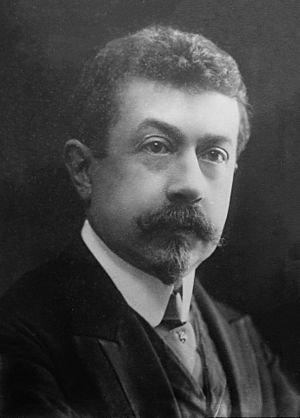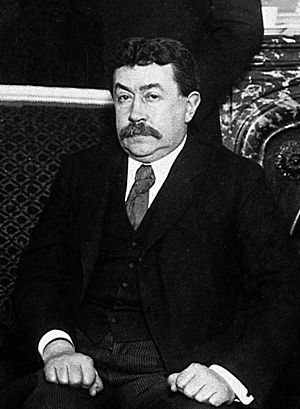Paul Painlevé facts for kids
Quick facts for kids
Paul Painlevé
|
|
|---|---|

Paul Painlevé in 1923
|
|
| Prime Minister of France | |
| In office 17 April 1925 – 28 November 1925 |
|
| President | Gaston Doumergue |
| Preceded by | Édouard Herriot |
| Succeeded by | Aristide Briand |
| In office 12 September 1917 – 16 November 1917 |
|
| President | Raymond Poincaré |
| Preceded by | Alexandre Ribot |
| Succeeded by | Georges Clemenceau |
| Minister of Air | |
| In office 3 June 1932 – 29 January 1933 |
|
| Prime Minister | Édouard Herriot Joseph Paul-Boncour |
| Preceded by | Jacques-Louis Dumesnil |
| Succeeded by | Pierre Cot |
| Minister of Finance | |
| In office 29 October 1925 – 28 November 1925 |
|
| Prime Minister | Himself |
| Preceded by | Joseph Caillaux |
| Succeeded by | Louis Loucheur |
| Minister of War | |
| In office 17 April 1925 – 29 October 1925 |
|
| Preceded by | Charles Nollet |
| Succeeded by | André Maginot |
| In office 20 March 1917 – 13 November 1917 |
|
| Prime Minister | Alexandre Ribot Himself |
| Preceded by | Lucien Lacaze |
| Succeeded by | Georges Clemenceau |
| President of the Chamber of Deputies | |
| In office 9 June 1924 – 21 April 1925 |
|
| Preceded by | Raoul Péret |
| Succeeded by | Édouard Herriot |
| Personal details | |
| Born | 5 December 1863 Paris |
| Died | 29 October 1933 (aged 69) Paris |
| Political party | PRS |
Paul Painlevé (born December 5, 1863 – died October 29, 1933) was a brilliant French mathematician and a very important politician. He served as Prime Minister of France twice. His first time was in 1917, during World War I. His second time was in 1925.
Painlevé started his career as a professor at the Sorbonne University in 1892. He later entered politics in 1906. During his first time as Prime Minister, he dealt with big events like the Russian Revolution and the United States joining World War I. He also helped calm down the French Army Mutinies.
In the 1920s, as Minister of War, he played a key role in building the Maginot Line. This was a strong line of forts to protect France. During his second time as Prime Minister, he faced a rebellion in Syria. This caused a lot of worry in France about its empire.
Contents
Paul Painlevé's Life Story
Early Years and Learning
Paul Painlevé was born in Paris, France. His family were skilled workers, and his father was a draughtsman, someone who draws detailed plans. Paul showed great talent in his studies from a young age. He first thought about becoming an engineer or a politician.
However, he chose to study mathematics. In 1883, he joined the École Normale Supérieure, a famous school in France. He earned his doctorate degree in mathematics in 1887. He also studied in Germany with famous mathematicians.
Painlevé wanted to be a professor. He taught at the University of Lille and then returned to Paris in 1892. There, he taught at several top universities, including the Sorbonne. In 1900, he became a member of the Académie des Sciences, a group of top scientists.
In 1901, he married Marguerite Petit de Villeneuve. Sadly, Marguerite passed away the next year when their son, Jean Painlevé, was born.
Painlevé's work on differential equations (math problems about how things change) led him to study how they applied to flight. He was very interested in engineering and became excited about the new field of aviation. In 1908, he was the first person in France to fly as a passenger with Wilbur Wright, one of the inventors of the airplane! In 1909, he started the first university course on aeronautics (the science of flight).
Amazing Math Work
Some math problems, called differential equations, can be solved using basic math like addition, subtraction, and special functions like those used in trigonometry. But many other important functions come from solving more complex differential equations.
Around 1900, Painlevé and other mathematicians found that certain difficult differential equations needed "new" types of functions to solve them. These new functions are now called the Painlevé transcendents. They are still important today in modern math and physics.
In 1895, he gave talks about differential equations. He also made a guess, called the Painlevé conjecture, about how objects move in space. In the same year, he wrote about the Painlevé paradox, which showed a strange problem in simple models of friction.
In the 1920s, Painlevé also looked at general relativity, Albert Einstein's new theory about gravity. In 1921, he suggested a new way to describe a black hole's edge. This helped scientists understand that this edge, called the event horizon, was a real boundary.
Starting His Political Career
Between 1915 and 1917, Painlevé was the French Minister for Public Instruction and Inventions. In 1915, he asked for a science sharing agreement between France and Britain. This led to French and British scientists working together to create the first active sonar. Sonar uses sound waves to detect objects underwater.
First Time as Prime Minister
Painlevé brought his interest in aviation, navy, and military matters into politics. In 1906, he became a representative for Paris. By 1910, he had left his university jobs. When World War I started, he became very involved in military groups. In 1915, he joined the government as Minister for Public Instruction and Inventions.
In March 1917, he became the Minister of War. He had to approve a very hopeful plan for a big attack in France. When the plan failed badly, Painlevé removed the general in charge and replaced him. He also helped manage the Russian Expeditionary Force in France.
On September 7, 1917, the Prime Minister at the time lost support, and Painlevé was asked to form a new government. He became Prime Minister.
Painlevé was a key person at a meeting that created the Supreme Allied Council. This group helped the Allied powers work together. He chose Ferdinand Foch to represent France, knowing Foch would be a great Allied commander. When Painlevé returned to Paris, his government was defeated, and he resigned on November 13, 1917. Georges Clemenceau took over. Foch later became the top commander for all Allied armies.
Second Time as Prime Minister
Painlevé was not very active in politics for a while. But in 1919, he became a critic of the right-wing government. By 1924, he worked with Édouard Herriot to form a group called the Cartel des Gauches. This group won the election, and Herriot became Prime Minister in June. Painlevé became the President of the Chamber of Deputies (like the speaker of the house).
Painlevé ran for President of France in 1924 but lost. Herriot's government recognized the Soviet Union and agreed to the Dawes Plan (a plan for Germany to pay back war debts). But France faced a money crisis, and in April 1925, Herriot's government fell. Painlevé became Prime Minister for the second time on April 17. However, he couldn't solve the money problems, and he had to resign on November 21.
Later Political Work
After Painlevé resigned, Aristide Briand formed a new government, and Painlevé became the Minister for War again. Even when Briand's government was replaced, Painlevé stayed in his role.
During his time as Minister of War, Painlevé was very important in creating the Maginot Line. This was a line of strong military forts built along France's eastern border. Painlevé designed much of it, but it was named after André Maginot because Maginot helped get public support and money for it. Painlevé remained Minister for War until July 1929.
From 1925 to 1933, Painlevé represented France in a group called the International Committee on Intellectual Cooperation. This was part of the League of Nations, an organization that worked for world peace.
In 1932, he was suggested for President of France again, but he decided not to run. Later that year, he became the Minister of Air. He suggested an international agreement to ban making bomber planes and to create a global air force to keep peace. His political career ended in January 1933 when the government fell.
Paul Painlevé passed away in Paris in October 1933. On November 4, he was buried in the Panthéon, a famous building in Paris where many important French people are laid to rest.
Honors and Recognition
- The aircraft carrier Painlevé was named after him.
- An asteroid, 953 Painleva, was named in his honor.
- A French math research lab, the Laboratoire Paul Painlevé, is named after him.
- The famous composer Maurice Ravel dedicated one of his songs to him in 1915.
His Writings
Paul Painlevé wrote many books and papers on mathematics and other topics, including:
- On singular lines of analytic functions (1887)
- Memory on first order differential equations (1892)
- A course on analytic theory of differential equations (1897, 1908)
- A course on real variable functions and polynomial development series (1905)
- A course on mechanics and machines (1907, 1908, 1909)
- Aeroplane (1909)
- Aviation (1910)
- Mechanics axioms, a critical study (1922)
- Notes on light spread (1922)
- Painlevé's three memories on relativity (1921-1922)
See also
 In Spanish: Paul Painlevé para niños
In Spanish: Paul Painlevé para niños
- List of people on the cover of Time Magazine: 1920s



